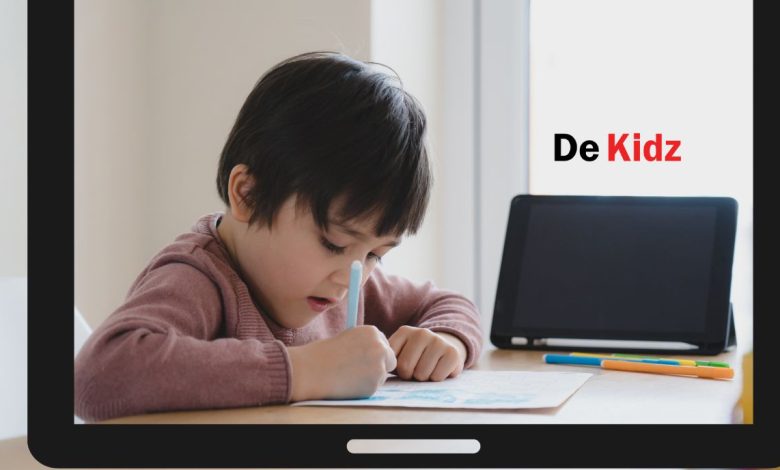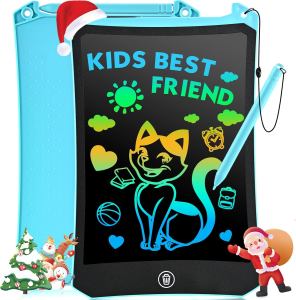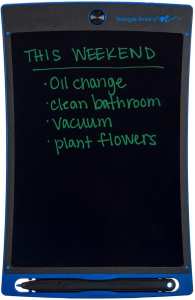The Best LCD Writing Tablet for Kids: Kids Drawing Tablet

In today’s digital age, where technology seamlessly blends with daily life, LCD writing tablets have emerged as a popular and innovative tool, especially among kids. These tablets represent a fusion of technology and creativity, offering a unique platform for children to express themselves artistically while engaging with a modern gadget. As we delve into the world of LCD writing tablets, we’ll explore how they are becoming a favorite for both parents and children alike.
LCD writing tablets harness the simplicity of traditional writing instruments and the convenience of digital technology, creating an interactive and eco-friendly alternative to paper and pens. They serve not only as a canvas for drawing and writing but also as an educational tool, enhancing learning experiences in fun and engaging ways. In this overview, we will shed light on the various aspects of LCD writing tablets, from their functionality to their role in fostering creativity and learning in children.
What is an LCD Writing Tablet?
An LCD writing tablet is a modern electronic device that utilises liquid crystal display (LCD) technology to provide a reusable, digital writing surface. It’s designed to mimic the experience of writing or drawing on paper without the need for actual paper or writing instruments like pens and pencils.
These tablets typically consist of a thin, lightweight screen on which you can write or draw with a stylus or even a finger. The pressure applied creates lines on the LCD screen, which are visually similar to ink on paper. One of the key features of these tablets is their ability to erase content with the press of a button, making them reusable and environmentally friendly.
LCD writing tablets are popular among children for various reasons. They offer a clean, no-mess way to draw, doodle, and write, which is particularly appealing for both parents and educators. Additionally, their portability and durability make them an ideal tool for on-the-go entertainment and learning. They are often used for educational purposes, such as practicing handwriting and arithmetic, or simply for drawing and creative expression.
Benefits of Best LCD Writing Tablet for Kids
The best LCD writing tablet for kids offers a range of benefits for children, encompassing both educational and developmental aspects, as well as contributing to eco-friendly practices.
- Educational Benefits:
- Enhances Learning: These tablets are excellent tools for practicing handwriting, spelling, and arithmetic. The tactile experience of writing on these tablets can aid in fine motor skill development and hand-eye coordination.
- Interactive Learning: Many LCD writing tablets come with features that make learning interactive and fun, such as different colors and stroke styles, which can enhance a child’s engagement and retention.
- Developmental Benefits:
- Fosters Creativity: With an easy-to-use surface, children can freely express their creativity through drawing and writing without the limitations of paper.
- Boosts Confidence: The ease of correcting mistakes on an LCD writing tablet can encourage kids to try new things without the fear of making errors, fostering a sense of confidence in their abilities.
- Eco-Friendly Aspect:
- Reduces Paper Waste: LCD writing tablets are a sustainable alternative to traditional paper and pens. By using these tablets, children learn the importance of reducing paper waste and contributing to environmental conservation.
- Reusable and Durable: Unlike paper, which can only be used once, these tablets can be used repeatedly, with the content easily erased, making them a long-lasting addition to a child’s learning tools.
- Safe and Convenient:
- Non-Toxic and Safe: These tablets are generally made from durable, non-toxic materials, making them safe for children to use.
- Portability: Lightweight and compact, LCD writing tablets are easy to carry, ideal for keeping children engaged and learning on the go, whether in the car, at appointments, or while traveling.
Overall, the best LCD writing tablet for kids offers a blend of educational and developmental benefits, making learning both fun and effective. Their eco-friendly nature also instills a sense of environmental responsibility in children from a young age.
Key Features to Look For in LCD Writing Tablets
When selecting the best LCD writing tablet for kids, certain features stand out as particularly important. These features not only enhance the user experience but also ensure the tablet meets your child’s educational and creative needs. Here’s what to look for:
- Screen Size:
- A larger screen offers more space for writing and drawing, making it ideal for older children or those using it for educational purposes.
- Smaller screens are more portable and may be better suited for younger children.
- Durability:
- Look for a tablet made with sturdy materials able to withstand drops and rough handling, especially important for younger kids.
- A durable build ensures the tablet lasts longer, offering better value for money.
- Battery Life:
- Opt for tablets with a long battery life to avoid frequent charging or battery replacements.
- Some models come with a low-power design, ensuring the battery lasts for months or even years.
- Stylus Design:
- The stylus should be comfortable to hold, especially for little hands, and ideally attached to the tablet to prevent loss.
- Some tablets offer styluses that can create different line thicknesses based on pressure, similar to real pens or pencils.
- Color Options:
- While many LCD writing tablets are monochrome, some models offer multiple color options on the screen, making the drawing experience more engaging.
- Erase Functions:
- A one-touch erase button is standard, but some tablets also offer partial erase functions, allowing for more precise corrections and edits.
- Memory Capabilities:
- Advanced models might include memory functions, enabling the saving and retrieval of drawings or notes, which is useful for tracking progress or revisiting ideas.
- Pressure Sensitivity:
- Tablets with pressure-sensitive screens can mimic a more natural writing and drawing experience, as the line thickness changes with pressure, just like with traditional writing instruments.
- Additional Features:
- Some tablets come with built-in magnets for easy attachment to metal surfaces or lock functions to prevent accidental erasing.
- Safety and Non-Toxic Materials:
- Ensure the tablet and stylus are made from child-safe, non-toxic materials.
Considering these features will help you choose the best LCD writing tablet that is not only fun and educational for your child but also practical and durable.
Top LCD Writing Tablets for Different Age Groups
Selecting the best LCD writing tablet for a child depends significantly on their age, as different age groups have varying needs and capabilities. Here’s a guide to some of the top models suitable for toddlers, preschoolers, and older kids, along with their age-appropriate features and functionalities.
- For Toddlers (Ages 1-3):
- Model Recommendation: Fisher-Price DoodlePro Slim
- Features: This tablet is designed with a durable frame, an easy-to-hold stylus, and a simple one-touch erase button. It’s lightweight and has rounded corners for safety.
- Functionality: The simplicity of this tablet is perfect for toddlers who are just starting to doodle and draw. It helps develop fine motor skills and hand-eye coordination.

- For Preschoolers (Ages 4-5):
- Model Recommendation: Boogie Board Play and Trace LCD Writing Tablet
- Features: This tablet comes with a translucent screen that allows kids to trace images, letters, and numbers. It includes a stylus suited for smaller hands and is built to be sturdy.
- Functionality: Ideal for preschoolers, this tablet not only allows for freehand drawing but also aids in learning how to write letters and numbers through tracing, enhancing early educational development.

- For Older Kids (Ages 6 and above):
- Model Recommendation: NEWYES Robot Pad
- Features: Features a larger screen with more sensitivity to pressure, allowing for varied line thickness. It includes advanced functions like partial erase, lock screen, and even memory storage in some models.
- Functionality: Suitable for older kids, this tablet offers more advanced drawing and writing capabilities. It can be used for schoolwork, art projects, and more detailed creative activities.

Each of these tablets is tailored to meet the developmental and educational needs of its respective age group. For toddlers, the focus is on safety and basic drawing, while preschoolers benefit from educational tracing features. Older kids, meanwhile, can enjoy more sophisticated functionalities that cater to their advanced writing and drawing skills.
Safety Considerations
When choosing an LCD writing tablet, especially for children, safety is a paramount concern. Here are key safety features to consider, ensuring that the tablet is not only fun and educational but also safe for use:
- Non-Toxic Materials:
- Ensure that the tablet and stylus are made from non-toxic materials. This is crucial since young children often put objects in their mouths. Look for products that are BPA-free and comply with safety standards.
- Secure Battery Compartments:
- The battery compartment should be securely fastened, preferably with a screw. This prevents young children from accessing the batteries, which can be a choking hazard and pose other risks if mishandled.
- Eye-Safe Screens:
- The screen should be gentle on the eyes. LCD screens that do not emit harmful blue light or glare are preferable, as they reduce the risk of eye strain, especially with prolonged use.
- Rounded Corners and Edges:
- Tablets with rounded corners and smooth edges are safer for children. They reduce the risk of injury from sharp edges, making them more suitable for younger users.
- Sturdy Construction:
- A well-built tablet that can withstand drops and rough handling is important, as children may not always be gentle with their belongings. A durable design ensures the tablet remains safe and functional over time.
- Appropriate Size and Weight:
- The tablet should be appropriately sized and lightweight for easy handling by children. A tablet that is too heavy or too large can be difficult for a child to use safely and comfortably.
- Stylus Attachment:
- A stylus that is attached to the tablet is less likely to get lost and also reduces the risk of small, detachable parts that could be a choking hazard for younger children.
- Low Radiation and Emission:
- Opt for tablets that have low or no radiation or electromagnetic emission to ensure they are safe for children’s health.
By considering these safety features, you can choose an LCD writing tablet that provides a secure and enjoyable learning and drawing experience for children.
Creative Uses of LCD Writing Tablets
LCD writing tablets are versatile tools that can be used in a variety of creative and educational ways. Here are some innovative ideas for how kids can use these tablets both for learning and fun:
- Practicing Handwriting:
- Children can use the tablet to practice writing letters, numbers, and their names. The easy-erase function allows for repeated practice without wasting paper.
- Drawing and Doodling:
- The tablet serves as a perfect canvas for drawing, sketching, and doodling. Kids can let their imagination run wild, creating artwork without any mess.
- Educational Games:
- Play spelling games, solve math problems, or draw puzzles. LCD writing tablets can be used for a variety of educational games that make learning interactive and enjoyable.
- Learning Languages:
- They are great tools for practicing writing characters in different languages, such as Chinese or Japanese, which can be particularly challenging on paper.
- Follow-Along Drawing:
- Kids can improve their artistic skills by following along with drawing tutorials and using the tablet to replicate what they see in a video or in a book.
- Storytelling:
- Encourage children to draw a series of pictures on the tablet to tell a story, fostering their narrative skills and creativity.
- Coloring Activities:
- While many LCD tablets are monochrome, some offer color options. Kids can enjoy coloring activities, filling in drawings with different shades.
- Educational Tracing:
- For younger children, the tablet can be used for tracing shapes, letters, and numbers, aiding in their cognitive development.
- Music Practice:
- Use the tablet for music practice, such as writing down notes, chords, or entire musical pieces.
- Memory Games:
- Draw a picture or write a word and have the child replicate it from memory, enhancing their observation and memory skills.
- Road Trip Entertainment:
- Perfect for long car rides, LCD writing tablets can keep kids occupied and entertained without the need for chargers or the internet.
- Grocery Lists or Reminders:
- Older kids can use these tablets for writing down grocery lists, reminders, or to-do lists, helping them to stay organized.
LCD writing tablets offer a world of possibilities for creative and educational activities, making them a valuable tool in a child’s developmental journey.
Comparing LCD Writing Tablets with Traditional Writing Methods
LCD writing tablets and traditional writing methods like paper and pencils each have their unique advantages and drawbacks. Here’s a comparison of the two:
Pros of LCD Writing Tablets:
- Eco-Friendly: LCD tablets are reusable, reducing paper waste and the need for multiple writing instruments.
- Portability: They are lightweight and easy to carry, making them ideal for travel or on-the-go use.
- Durability: Unlike paper, they are not prone to tearing or getting damaged by liquids.
- Cost-Effective in the Long Run: Though there’s an upfront cost, LCD tablets can be more economical over time, as there’s no need to continually purchase paper or pencils.
- Mess-Free: They offer a clean way to write and draw without the mess of ink or crayon marks.
- Technology Integration: They can be a stepping stone for children to become comfortable with digital technology.
Cons of LCD Writing Tablets:
- Battery Dependency: Most LCD tablets require batteries, which need to be replaced or charged.
- Limited Sensory Experience: The tactile feel of writing on paper with a pencil is lost, which can be important for early development.
- Monochrome Output: Many LCD tablets do not offer color options, limiting the vibrancy of drawings.
- Screen Time Concerns: While they don’t emit light like other screens, some parents may still prefer to limit all forms of screen exposure.
Pros of Traditional Writing Methods (Paper and Pencils):
- Sensory Experience: Writing on paper provides a tactile experience that is beneficial for fine motor skill development.
- No Technology Required: No need for batteries or charging.
- Creativity: Offers more freedom in terms of color, texture, and style.
- Affordability: Paper and pencils are generally inexpensive and readily available.
Cons of Traditional Writing Methods:
- Not Eco-Friendly: Continuous use of paper contributes to environmental waste.
- Less Durable: Paper can be easily damaged and is not reusable.
- Portability: Carrying paper and pencils is less convenient, and they can be lost or damaged in transit.
- Messy: Can lead to ink or pencil smudges, requiring clean-up.
In conclusion, both LCD writing tablets and traditional writing methods have their place in a child’s learning and creative processes. The choice between them can depend on the specific needs, preferences, and values of the family or educational setting.
Where to Buy and Price Range
LCD writing tablets are widely available and come in various price ranges to suit different budgets. Here’s where you can find them and what you can expect in terms of pricing:
- Online Retailers:
- Websites like Amazon, eBay, and Best Buy offer a wide selection of LCD writing tablets from various brands.
- You can find detailed product descriptions, customer reviews, and often competitive pricing on these platforms.
- Electronics Stores:
- Major electronics retailers like Walmart, Target, and Staples carry LCD writing tablets in their physical stores as well as online.
- Shopping in-store allows you to see the product firsthand and sometimes test it out.
- Specialty Children’s Stores:
- Stores that specialize in children’s educational toys and supplies often stock LCD writing tablets, particularly those designed for younger kids.
- These stores might offer models that are more focused on educational aspects.
- Office Supply Stores:
- LCD writing tablets can also be found in office supply stores, as they are useful for note-taking and quick sketches.
- Price Range:
- The price of LCD writing tablets can vary widely based on the brand, size, features, and quality.
- Basic models can start as low as $10 to $20, making them quite affordable.
- More advanced models with features like color screens, memory functions, or larger sizes can range from $30 to $60 or more.
- Educational Catalogs and Websites:
- If you’re looking for tablets specifically designed for educational purposes, browsing through catalogs and websites that specialize in educational tools might be beneficial.
- Discount Stores:
- For more budget-friendly options, you can check out discount stores, where you might find affordable models at lower prices.
When purchasing an LCD writing tablet, consider the intended use—whether for simple doodling, educational purposes, or as a digital notepad. This will help you choose the right model within your budget that meets your specific needs.
User Reviews and Feedback
Gathering insights from parents and kids who have used LCD writing tablets provides valuable information on their real-world performance and usability. Here’s a summary of common feedback:
- Ease of Use:
- Parents often appreciate the simplicity of these tablets. Kids can use them without much instruction, making them suitable for even very young children.
- The one-touch erase feature is frequently highlighted as a convenient way to clear the screen quickly.
- Durability:
- Many users report that these tablets are quite durable and able to withstand drops and rough handling, which is a significant plus in households with active kids.
- Educational Value:
- Parents and educators often mention the educational benefits of these tablets, particularly for handwriting practice, arithmetic, and drawing.
- They are seen as a good tool for encouraging creativity and learning in a fun, tech-friendly way.
- Portability:
- The lightweight and compact design of these tablets is a big hit among families, especially for use during travel, in cars, or at restaurants to keep kids engaged.
- Battery Life:
- The long battery life of most LCD writing tablets is frequently praised, with many models lasting months or even years before needing a battery change.
- Screen Quality:
- Some users note that the quality of the LCD screen can vary between models. Higher-end tablets tend to have better screen sensitivity and visibility.
- Limitations in Features:
- While the simplicity of the tablets is a plus, some parents and older kids wish for more advanced features like color options or the ability to save their work.
- Environmental Impact:
- Eco-conscious parents often mention the benefit of reducing paper waste as a significant advantage of using an LCD writing tablet.
- Value for Money:
- The consensus is that LCD writing tablets offer good value for money, especially considering their durability and the range of uses they offer.
- Entertainment Factor:
- Kids love the fun aspect of these tablets. Parents often mention that their children enjoy using them for drawing and playing simple games.
In summary, LCD writing tablets are well-received for their ease of use, durability, and educational value. While they are generally appreciated for their basic functionality, some users express a desire for more advanced features in future models.
FAQs for LCD Writing Tablets
What is an LCD writing tablet, and how does it work?
An LCD writing tablet is a digital device that uses liquid crystal display technology to provide a reusable writing or drawing surface. It works by applying pressure to the screen with a stylus or finger, which creates lines or images. The content can be easily erased with a button.
Are LCD writing tablets good for kids?
Yes, they are great for kids as they offer a fun and interactive way to draw, write, and learn. They are also portable, durable, and eco-friendly, making them suitable for children.
Can LCD writing tablets help in a child’s education?
Absolutely. They can be used for handwriting practice, solving math problems, learning to draw, and other educational activities, making learning interactive and engaging.
How long do the batteries last in an LCD writing tablet?
Most LCD writing tablets have a long battery life, often lasting for months or even years, depending on the frequency of use and the tablet model.
Is the screen on an LCD writing tablet safe for children’s eyes?
Yes, LCD screens on these tablets are generally safe as they don’t emit light like other electronic screens, reducing the risk of eye strain.
Can the drawings or writings be saved on these tablets?
Basic models don’t typically have a save function, but some advanced models do come with memory capabilities to save and retrieve drawings or notes.
Are LCD writing tablets durable?
Yes, they are designed to be durable and can withstand drops and rough handling, which is ideal for use by children.
Can these tablets be used for drawing in colors?
While most LCD writing tablets are monochrome, some models offer color display options.
Where can I buy an LCD writing tablet?
They are available at various online retailers, electronics stores, children’s stores, and office supply stores.
What should I consider when buying an LCD writing tablet for my child?
Consider the tablet’s size, durability, battery life, stylus design, and any additional features like color options or memory capabilities that suit your child’s age and needs.
Conclusion
In conclusion, the best LCD writing tablet for kids has emerged as a valuable tool in the realm of a child’s learning and creativity. These tablets blend the simplicity of traditional writing and drawing with the advantages of modern technology, offering a unique platform for children’s educational and creative development. Their ease of use, durability, and eco-friendly nature make them an excellent choice for parents and educators looking to enhance a child’s learning experience.
The versatility of LCD writing tablets allows for a wide range of uses, from practicing handwriting and arithmetic to encouraging artistic expression through drawing and doodling. Their portability makes them ideal for on-the-go activities, providing entertainment and educational value during travel or while waiting. Additionally, the environmental benefit of reducing paper waste aligns with teaching children the importance of sustainability.
As we have explored the various aspects and benefits of LCD writing tablets, we encourage you to consider how one of these innovative devices could fit into your child’s daily routine. Whether for educational purposes, creative expression, or simply as a fun and eco-friendly alternative to paper, an LCD writing tablet can be a significant addition to your child’s developmental toolkit. We invite you to explore the options available and choose the best LCD writing tablet that meets your child’s needs and preferences, ensuring a blend of learning, creativity, and fun.

Tuhin is a distinguished expert in child development and product development and is a proud alumnus of Dhaka University with a postgraduate degree in child development. As the Product Development Manager at Apparel Village Limited, he skillfully merges his academic background with innovative product strategies, focusing on creating child-friendly and developmentally beneficial products. Tuhin’s unique approach, rooted in child psychology, positions him as a visionary in the industry, continuously contributing to research and setting trends in both child development and product innovation.



